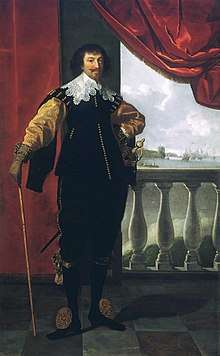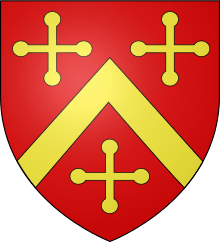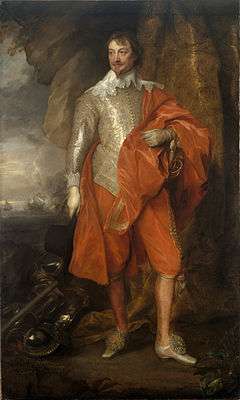Robert Rich, 2nd Earl of Warwick
Robert Rich, 2nd Earl of Warwick (5 June 1587 – 19 April 1658) was an English colonial administrator, admiral, and Puritan.
Robert Rich, 2nd Earl of Warwick | |
|---|---|
 The Earl of Warwick by Daniël Mijtens | |
| Born | 5 June 1587 |
| Died | 19 April 1658 |
| Parent(s) | Robert Rich, 1st Earl of Warwick Penelope Devereux, Lady Rich |


Origins
He was the eldest son of Robert Rich, 1st Earl of Warwick, 3rd Baron Rich (1559-1619) by his wife Lady Penelope Devereux (1563-1607), a daughter of Walter Devereux, 1st Earl of Essex. His younger brother was Henry Rich, 1st Earl of Holland. The family was descended from Richard Rich, 1st Baron Rich, who rose to political prominence in the reign of King Edward VI, and was previously an associate of Thomas Cromwell during the reign of Henry VIII.
Early life
He succeeded to his father's title as Earl of Warwick in 1619. Early developing interest in colonial ventures, he joined the Guinea, New England, and Virginia companies, as well as the Virginia Company's offspring, the Somers Isles Company. Warwick's enterprises involved him in disputes with the British East India Company (1617) and with the Virginia Company, which in 1624 was suppressed as a result of his action. In August 1619, one of the privateer ships owned by the Earl, the White Lion, delivered the first recorded enslaved Africans to British North America. The ship, flying a Dutch flag, landed at what is now Hampton, Virginia with approximately 20 Africans from the present-day Angola. They had been removed by the British crew from a Portuguese slave ship, the "São João Bautista".[1][2]
In 1627 he commanded an unsuccessful privateering expedition against the Spaniards.[3]
He sat as a Member of Parliament for Maldon for 1604 to 1611 and for Essex in the short-lived Addled Parliament of 1614.[4]
Colonial ventures
Warwick's Puritan connections and sympathies gradually estranged him from the court but promoted his association with the New England colonies. In 1628 he indirectly procured the patent for the Massachusetts Bay Colony, and in 1631 he was granted the "Saybrook" patent in Connecticut. Forced to resign the presidency of the New England Company in the same year, he continued to manage the Somers Isles Company and Providence Island Company, the latter of which, founded in 1630, administered Old Providence on the Mosquito Coast. Meanwhile, in England, Warwick opposed the forced loan of 1626, the payment of ship money, and Laud's church policy.[3]
His Richneck Plantation was located in what is now the independent city of Newport News, Virginia. The Warwick River, Warwick Towne, Warwick River Shire, and Warwick County, Virginia are all believed named for him, as are Warwick, Rhode Island and Warwick Parish in Bermuda (alias The Somers Isles). The oldest school in Bermuda, Warwick Academy, was built on land in Warwick Parish given by the Earl of Warwick; the school was begun in the 1650s (its early records were lost with those of the Warwick Vestry in a twentieth-century shipwreck), though the school places its founding officially in 1662.
In September 1640 Warwick signed the Petition of Twelve to Charles I, asking the king to summon another parliament.[5]
Civil War period
In 1642, following the dismissal of the Earl of Northumberland as Lord High Admiral, Warwick was appointed commander of the fleet by Parliament.[6] In 1643 he was appointed head of a commission for the government of the colonies, which the next year incorporated Providence Plantations, afterwards Rhode Island, and in this capacity he exerted himself to secure religious liberty.[3]
As commander of the fleet, in 1648, Warwick retook the 'Castles of the Downs' (at Walmer, Deal, and Sandown) for Parliament, and became Deal Castle's captain 1648–53.[7] However, he was dismissed from office on the abolition of the House of Lords in 1649. He retired from national public life, but was intimately associated with Cromwell, whose daughter Francis married his grandson and heir, also Robert Rich, in 1657.[3]
Marriages and issue
Robert Rich married three times:
- Firstly, in February 1605, to Frances Hatton (1590–1623), daughter and heiress of Sir William Hatton (1560-1597) (alias Newport) by his wife Elizabeth Gawdy.[8] By Frances Hatton he had issue including:
- Robert Rich, 3rd Earl of Warwick (1611–1659), eldest son and heir;
- Charles Rich, 4th Earl of Warwick (1623?–1673), who succeeded his brother in 1659.
- Lady Frances Rich (Countess of Scarsdale), who married Nicholas Leke, 2nd Earl of Scarsdale (1612–1681);
- Lady Anne Rich (1604–14 February 1641/2) (Countess of Manchester and Viscountess Mandeville), who in 1625 married (as his 2nd wife) Edward Montagu, 2nd Earl of Manchester and had issue, including Robert Montagu, 3rd Earl of Manchester. A double portrait survives[9] of her and her sister Lady Essex Rich by Anthony van Dyck.
- Lady Lucy Rich (1615–after 1635) (Countess of Radnor), who married John Robartes, 1st Earl of Radnor
- Lady Essex Rich, depicted with her sister Anne in a double portrait by Anthony van Dyck.
- Secondly, between 12 March 1625 and 20 January 1626, he married Susan Rowe (1582–1646), a daughter of Sir Henry Rowe, Lord Mayor of London, and widow of William Holliday (c.1565-1624), Alderman of London, a wealthy London merchant and chairman of the East India Company.[10]
- Thirdly he married Eleanor Wortley, widow successively of Sir Henry Lee and of Edward Radclyffe, 6th Earl of Sussex; after Warwick's death she made yet another marriage to Edward Montagu, 2nd Earl of Manchester, in modern eyes an unusual marriage since he had previously been married to her step-daughter Anne Rich. She was "a vain, petulant and grasping woman who had reached the top rungs of the social ladder through successive marriages to rich men."[11]
Footnotes
- https://www.nationalgeographic.com/archaeology-and-history/magazine/2019/07-08/virginia-first-africans-transatlantic-slave-trade/, 400 years ago, enslaved Africans first arrived in Virginia
- https://time.com/5653369/august-1619-jamestown-history/, The First Africans in Virginia Landed in 1619. It Was a Turning Point for Slavery in American History—But Not the Beginning
-

- "RICH, Sir Robert (c.1588-1658), of Wallington, Norf., Hackney, Mdx. and Allington House, Holborn, Mdx.; later of Leez Priory, Essex". History of Parliament Trust. Retrieved 16 March 2019.
- Kelsey 2004
- 'July 1642: Ordinance for the Earl of Warwick to remain in his Command of the Fleet.', Acts and Ordinances of the Interregnum, 1642-1660 (1911), p. 12. URL: http://www.british-history.ac.uk/report.asp?compid=55732. Date accessed: 13 April 2007.
- 13 July 1648 - 'Taking of Walmer Castle' URL: http://www.british-history.ac.uk/report.asp?compid=25420#s6 Date accessed: 6 August 2007.
- Aughterson 2004; Gowdy 1919, pp. 39–41; Nicolas 1847, p. 502; Kelsey 2004.
- "Double portrait of the Essex sisters: the countess of Manchester and lady Anne Rich (d. c. 1655)" However, the sisters were the Rich sisters, not the Essex sisters; the Countess of Manchester was Lady Anne Rich (who died c. 1641/2), and her sister was Lady Essex Rich. Source Cracroft's Peerage and other sources.
- Aughterson 2004; Gowdy 1919, pp. 39–41; Kelsey 2004.
- (Miriam Slater, Family Life in the Seventeenth Century: the Verneys of Claydon House 1984:17).
References
- Aughterson, Kate (2004). Hatton, Elizabeth, Lady Hatton [née Lady Elizabeth Cecil] (1578-1646). Oxford Dictionary of National Biography. Retrieved 17 September 2012.CS1 maint: ref=harv (link)
- Gowdy, Mahlon M. (1919). A Family History Comprising the Surnames of . . . Gawdy. Lewiston, Maine: Journal Press.CS1 maint: ref=harv (link)
- Kelsey, Sean (2004). Rich, Robert, second earl of Warwick (1587-1658). Oxford Dictionary of National Biography. Retrieved 18 September 2012.CS1 maint: ref=harv (link)
- Nicolas, Harris (1847). Memoirs of the Life and Times of Sir Christopher Hatton. London: Richard Bentley.CS1 maint: ref=harv (link)
External links
![]()
| Political offices | ||
|---|---|---|
| Preceded by The Earl of Sussex |
Lord Lieutenant of Essex jointly with The Earl of Sussex 1625–1629 The Earl of Portland 1629–1635 The Lord Maynard 1635–1640 The Earl of Carlisle 1641–1642 1625–1642 |
English Interregnum |
| Preceded by The Lord Maynard |
Custos Rotulorum of Essex 1640–1642 |
Succeeded by James Hay, 2nd Earl of Carlisle |
| Peerage of England | ||
| Preceded by Robert Rich |
Earl of Warwick 1619–1658 |
Succeeded by Robert Rich |
| Baron Rich (descended by acceleration) 1619–1641 | ||